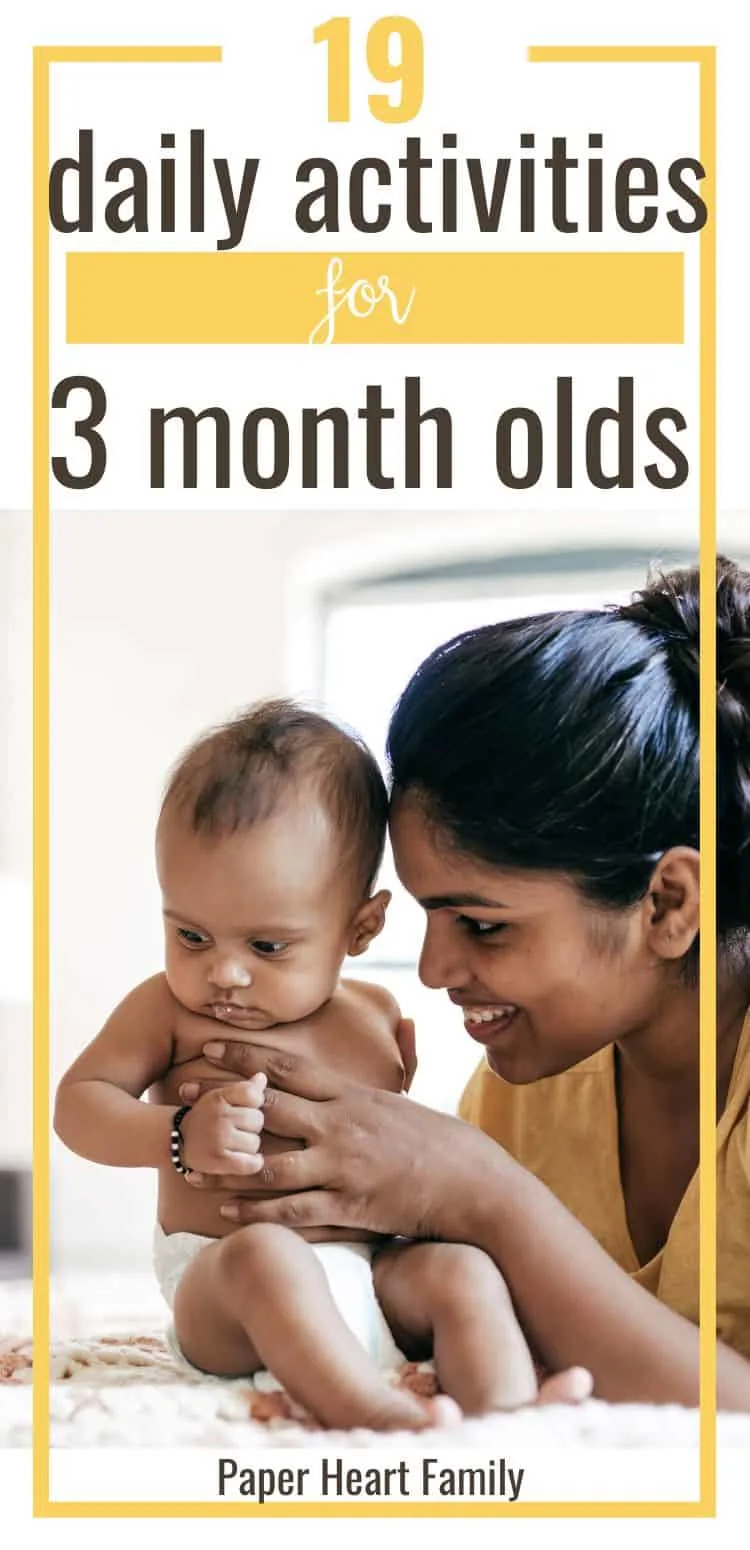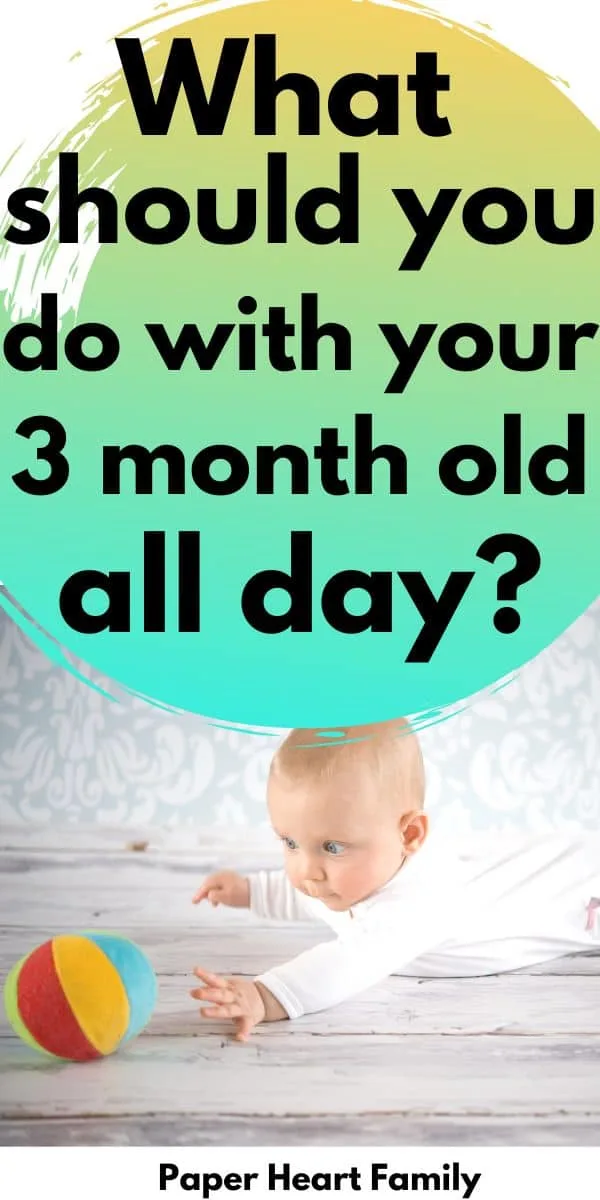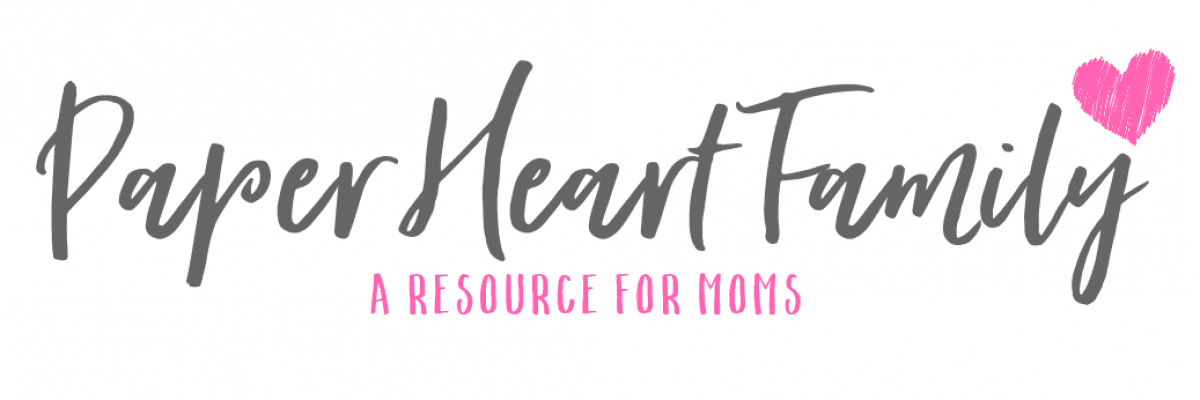Wondering what to do with a 3 month old baby when he’s awake?
My best advice is to keep it simple.
You might feel like your baby needs more stimulation, but at 3 months old, your baby is amazed by, well, pretty much everything!
Every baby is different, I realize. Some babies are demanding more attention at this age and some are content to just observe.
My first baby wanted to be entertained, even at the age of 3 months! She always wanted to be moving and exploring and interacting.
This list is full of simple things that I used to do with her.
My second baby, on the other hand, either nursed or slept for the first three months of her life. Seriously.
She was never awake and I didn’t have the opportunity to do any of these activities with her.
It might also be helpful to know what the typical milestones are for this age, so that you can focus on activities that will work to develop these skills.
Three Months Of Age Developmental Milestones
This list is a general list of milestones for 3 month olds. These are important skills however remember that baby’s develop at different rates and at their own pace.
- May raise head and chest when on tummy
- Opens and closes his hands
- Pushes down on his legs when on a flat surface (first stage of walking)
- May swipe at dangling objects
- May grasp at toys
- Can start to follow moving objects with his eyes
- Makes cooing noises
- Turns his head toward sounds (such as the sound of your voice)
- Smiles
- Enjoys playing
(source)
This post contains affiliate links.
Here are the best activities for your baby.
These infant development activities could be useful too.

Activities For 3 Month Olds
1. Talk To Your Baby
Talking to your baby is probably one of the BEST things you could do for him.
Through talking to him, he’s learning so many language skills: he’s going to learn the structure of the language, expand his vocabulary, learn about maintaining eye contact.
And it’s of course so simple.
Talk to your baby whenever you can: when he’s in the sling, when you’re making dinner and he’s in the bouncer near you, when your changing his diaper, when you’re going for a walk, etc.
2. Read To Your Baby
You might think that your baby is too young for you to read to him, but that’s not true. This is the perfect time to start. You could read to your baby from day one of his life, and in my opinion, the sooner the better. It’s such a special time to share with your baby.
Reading, just like talking, is going to do great things for your baby’s language development.
And I would say it’s a good idea to start a routine of reading now, so that when he becomes more mobile he will be more likely to sit while you read.
Your 3 month old will love looking at the pictures and listening to your voice. And the repetition that your baby will get from reading the same books over and over again is so helpful for speech development, too.
3. Sing To Your Baby
Just like reading and speaking, singing is another simple activity and is a great way to interact with your child and develop future language skills.
These baby action songs are super engaging!
4. Implement Daily Tummy Time
I know that some babies just don’t like tummy time, but it’s still something that you should try to incorporate into your baby’s daily schedule.
Tummy time helps to develop strong neck muscles and shoulder muscles and develops fine motor skills essential for some very big milestones (sitting up, rolling over and crawling).
It can also help prevent positional plagiocephaly (flat spots on the head).
The best thing to do if your baby hates tummy time is to do it on your chest. Get into a semi-reclined position and lay your baby on top of you, stomach to stomach. This way your baby can look at you and feel more cozy during tummy time.
5. Listen To Music
Put on some music (it doesn’t have to be nursery rhymes!) and start dancing around with your baby.
6. Get A Play Mat
Allow your baby to have some stimulating time away from you.
I think the Fisher Price Kick’N’Play is a great play mat for babies because it has dangly toys but it also has a piano at the bottom of the mat that your baby will “play” when he kicks his feet. Both of my kids loved it.
Baby Einstein’s version looks pretty amazing, too.

7. Imitate Your Baby
Imitating your baby is super entertaining to him, and is a great way to teach him the back and forth manner of communication.
According to a study done by Lund University, babies like being imitated, and are more friendly toward imitators. Babies look and smile at those who imitate them more.
8. Mirror Play
There are so many benefits for your baby by using a mirror to look at, play with, etc. Not to mention, it’s super entertaining for young babies to see their own reflection and different facial expressions.
Mirrors help babies to learn how to reach, point and pat. It aids in the development of many visual skills, cognitive skills and even with language skills.
Put your baby in front of a mirror and watch as he falls in love with himself!
9. Play Peek-A-Boo
Playing Peek-A-Boo is such a classic fun game, but for good reason. Playing this simple fun activity will start to teach your baby the concept of object permanence.
He will start to realize that even if he can’t see you, you are still there.
Developing this skill is immensely important once separation anxiety hits.
10. Hold Toys For Your Baby
Holding a toy or different objects in front of your baby and moving it around encourages your baby to grasp it, or at least try to. It’s a great hand-eye coordination activity.
The simple act of looking at the toy is beneficial for babies, especially if they are high contrast toys.
High contrast toys (toys that are black and white for example) can not only strengthen your baby’s mind but can also improve your baby’s vision.
11. Help Your Baby Discover His Own Hands And Feet
A baby’s hands and feet can become their favorite toy at this age, once they are discovered. If your baby hasn’t discovered his hands and feet yet, you can help him out by:
- clapping your baby’s hands together
- stretching your baby’s little arms up overhead
- pedal your baby’s legs
- place toys in your baby’s hands
- tickle your baby’s face with his feet
- get some Lamaze hand and foot finders to put on your baby’s wrists and ankles
12. Have Age-Appropriate Toys Available
At this point, you do NOT need a lot of toys, because your baby may not play with them anyway. However, here are a few favorite baby toys that have good reviews with the 3 month old crowd.
- Oball– The Oball is a super easy ball to grasp (and can easily be placed in your baby’s hand)
- Sophie The Giraffe– Sophie the Giraffe is essentially a teether made out of natural rubber that is easy to hold, squeaks and is high-contrast.
- Beatbo– Beatbo is a soft, plush toy that lights up and sings when his belly is pushed. The lights also move with the music. It’s a great toy for baby’s who love music and dancing.
13. Stand Your Baby Up
Strengthen those leg muscles by standing your baby up on the floor or on your knees facing you.
14. Take Your Baby Where You Go In A Sling
A baby carrier is going to allow your baby to see a lot of different things which stimulate his senses while also giving him a lot of close contact with you.
Oh, and of course it’s an easy way to allow you to have your hands free to do something for you. Win, win!
15. Get Outside At Least Once A Day
Especially if your 3 month old has a typical fussy period at some point in the day, making getting outside one of your daily activities can nip that fussiness right in the bud.
16. Get Out Of The House
Just getting a change of scenery is so beneficial for your baby (and maybe even more so for you). Go to the mall and walk around or to the local park. Even going to Target will be exciting for your baby.
17. Enroll Your Baby In Playtime At The Local Library
Your baby won’t really “play” with the other babies at play group, but he will start to be able to see other babies. Even more importantly, you will be able to connect with other moms who are going through the same stages that you are experiencing.
18. Extend Bath Time
If your baby loves bath time, extend it! Let him play and splash and get all wrinkly. Refill the tub with warm water a few times and let your baby enjoy bath time.
19. Give Baby Your Finger
Your baby can most easily develop his grasp by holding onto your finger. There’s no better feeling than your baby holding on to your finger, right?
So that’s it! Like I said, keep it simple and enjoy this stage, but also be present in your baby’s learning process. Your baby will only be a baby for a very short time.
It will get easier soon! Your baby will start to hold onto toys and scoot around very soon.
Related:


